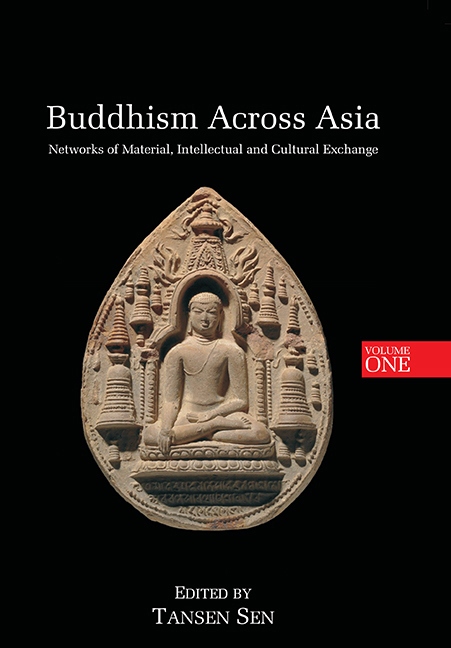Book contents
- Frontmatter
- Dedication
- Contents
- Introduction: Buddhism in Asian History
- Part I Tran smissions of Buddhism Before the Seventh Century
- Part II Buddhism Across Asia between the Seventh and Fifteenth Centuries
- 8 On Kuiji's Sanskrit Compound Analyses: Transmission of Sanskrit Grammar in the Early Tang Dynasty
- 9 Abridged Teaching (Lüe Jiao): Monastic Rules between India and China
- 10 From Nālandā to Chang'an: A Survey of Buddhist Libraries in Medieval China (618-907)
- 11 Multiple Traditions in One Ritual: A Reading of the Lantern-Lighting Prayers in Dunhuang Manuscripts
- 12 The Idea of India (Tenjiku) in Pre-Modern Japan: Issues of Signification and Representation in the Buddhist Translation of Cultures
- 13 The Buddhist Image Inside-Out: On the Placing of Objects Inside Statues in East Asia
- 14 Indian Abhidharma Literature in Tibet: A Study of the Vijñāna Section of Sthiramati's Pañcaskandhakavibhāṣā
- 15 From Aśoka to Jayavarman VII: Some Reflections on the Relationship between Buddhism and the State in India and Southeast Asia
- 16 The Theravāda Buddhist Ecumene in the Fifteenth Century: Intellectual Foundations and Material Representations
- Part III Buddhist Connections after the Fifteenth Century
- List of Contributors
- Index
- Miscellaneous Endmatter
15 - From Aśoka to Jayavarman VII: Some Reflections on the Relationship between Buddhism and the State in India and Southeast Asia
from Part II - Buddhism Across Asia between the Seventh and Fifteenth Centuries
Published online by Cambridge University Press: 21 October 2015
- Frontmatter
- Dedication
- Contents
- Introduction: Buddhism in Asian History
- Part I Tran smissions of Buddhism Before the Seventh Century
- Part II Buddhism Across Asia between the Seventh and Fifteenth Centuries
- 8 On Kuiji's Sanskrit Compound Analyses: Transmission of Sanskrit Grammar in the Early Tang Dynasty
- 9 Abridged Teaching (Lüe Jiao): Monastic Rules between India and China
- 10 From Nālandā to Chang'an: A Survey of Buddhist Libraries in Medieval China (618-907)
- 11 Multiple Traditions in One Ritual: A Reading of the Lantern-Lighting Prayers in Dunhuang Manuscripts
- 12 The Idea of India (Tenjiku) in Pre-Modern Japan: Issues of Signification and Representation in the Buddhist Translation of Cultures
- 13 The Buddhist Image Inside-Out: On the Placing of Objects Inside Statues in East Asia
- 14 Indian Abhidharma Literature in Tibet: A Study of the Vijñāna Section of Sthiramati's Pañcaskandhakavibhāṣā
- 15 From Aśoka to Jayavarman VII: Some Reflections on the Relationship between Buddhism and the State in India and Southeast Asia
- 16 The Theravāda Buddhist Ecumene in the Fifteenth Century: Intellectual Foundations and Material Representations
- Part III Buddhist Connections after the Fifteenth Century
- List of Contributors
- Index
- Miscellaneous Endmatter
Summary
Undoubtedly, Aśoka (c. 268-232 bce) and Jayavarman VII (1182-1220?), two of the greatest rulers of India and Southeast Asia were Buddhists by any definition. Aśoka produced the earliest and largest number of inscriptions of early India, all of them with a clear Buddhist connotation. And Jayavarman VII left to us, most likely, not only Southeast Asia's largest number of royal inscriptions but also the largest number of monuments in Angkor, all of them of a Buddhist nature as are his inscriptions, too. Aśoka and Jayavarman were not only rulers of India's and Southeast Asia's most impressive early and medieval states, which may rightly be termed as empires, but under both of them, their states even reached their climax. However, the puzzling problem is that their deaths were followed by an inexorable decay of their erstwhile great empires. What matters in this context is that this decay was linked with a reaction against the Buddhism propagated by these great Buddhist rulers. The Buddhist tradition of a Brahmanical counteraction against Buddhism under the Śungas has been refuted with good cause. After all, the marvellously carved railings of the Buddhist stūpa of Bharhut belong to the age of the Śungas. But none of Aśoka's weak successors on the Mauryan throne is known to have followed his dhamma policy. Pu|syamitra Śunga, who killed the last Maurya ruler in 187 bce, is known to have conducted two horse sacrifices, an act detrimental to Aśoka's dhamma. Jayavarman VII's reign, however, was definitely “followed by a violent reaction accompanied by acts of vandalism.” Buddhist temples founded by Jayavarman were converted to Śaivism which seems to have been reintroduced as the state cult. Hundreds of small Buddhist images were systematically destroyed in Preah Khan and Ta Prohm. In 1933, broken pieces of Bayon's principal image, a 3.6-m Buddha, were discovered at the bottom of its central well. The crucial question is whether the causes of the posthumous fate of Aśoka's and Jayavarman's great achievements have to be traced to the biography of these rulers, or whether it represents, respectively, an inherently ambivalent nature of the relationship between Buddhism and the state in India and pre-Theravāda Buddhist Southeast Asia.
Let me begin with some detailed deliberations on Aśoka.
- Type
- Chapter
- Information
- Buddhism Across AsiaNetworks of Material, Intellectual and Cultural Exchange, volume 1, pp. 327 - 346Publisher: ISEAS–Yusof Ishak InstitutePrint publication year: 2014



